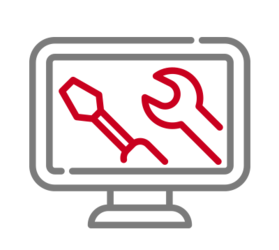Peek into the engine room
verinice.veo relies on both established and innovative technologies for GRC management. The platform is open source and uses open standards to promote digital sovereignty and transparency. In this way, we also address the dynamic requirements of modern companies and institutions as well as the demands for user-friendliness.
Our dedicated development team focuses on continuous optimization and innovation to further advance the functionality and efficiency of our solutions. Here we present some of the central technological principles the new verinice generation is based on.
Interested in working with us or finding out more? Try verinice.veo, join the forum or contact our developers directly to find out more.

OpenAPI
verinice.veo uses OpenAPI to facilitate integration with other systems. OpenAPI enables a complete and standardized description of RESTful APIs. Its use ensures that interfaces are consistent and easy to understand. This simplifies development and maintenance.
The documentation in OpenAPI format allows developers to quickly look up the available endpoints, parameters and response formats and use the APIs efficiently. This promotes the interoperability and integration of verinice.veo with other applications and platforms.

Microservices
verinice.veo is based on a microservices architecture. This allows individual components to be developed, provided and scaled independently of each other. The modularity promotes agility and flexibility of the software.
Microservices help to ensure that verinice.veo remains robust and resilient – even when the individual services are used to varying degrees.

Container
verinice.veo uses container technologies compliant with the Open Container Initiative (OCI) to package and deploy applications in containers. This containerization ensures a consistent and isolated execution environment, regardless of the underlying infrastructure.
Thanks to container platforms such as Docker or Podman, verinice.veo can be operated reliably and efficiently on different platforms. This increases the portability and scalability of the solution.

Kubernetes
Kubernetes plays a central role in the orchestration and management of container-based applications in verinice.veo. By using Kubernetes, verinice.veo can automatically scale, distribute loads and independently compensate for failures. This enables highly available and fail-safe operation in complex cloud environments.
verinice.veo is horizontally scalable to meet the requirements of companies of any size. Whether it is a question of increasing user numbers or increased data volumes: verinice.veo can dynamically adapt resources to ensure consistent performance.
In suitable cloud environments, verinice.veo also supports elasticity. This enables adaptation to changing load conditions at certain times of the day or in reporting periods. The automatic provisioning or release of resources optimizes efficiency and costs while maintaining the same user experience.

Keycloak
To manage users and access rights, verinice.veo relies on Keycloak – an open source identity and access management solution. Keycloak offers functions such as Single Sign-On (SSO), authentication and authorization and ensures the secure management of user data within the platform.
Connecting to existing LDAP or Active Directory systems is also possible.

RabbitMQ
RabbitMQ acts as a messaging broker in verinice.veo. This enables reliable communication between the microservices. RabbitMQ processes messages asynchronously and independently. This separates compute-intensive operations and load peaks over time, which contributes to the stability and scalability of the entire platform.

VUE.js
verinice.veo relies on VUE.js for the development of its user interfaces. This modern JavaScript framework makes it possible to create responsive and performant frontends that offer an outstanding user experience.
VUE.js helps to ensure that verinice.veo has an intuitive and user-friendly interface – and is consistently functional on different devices and browsers.

